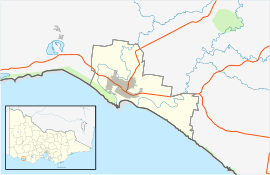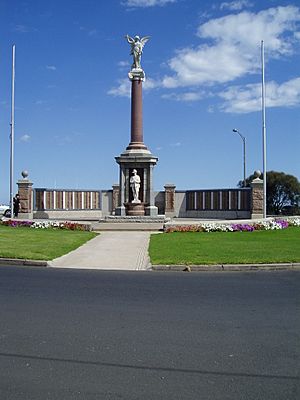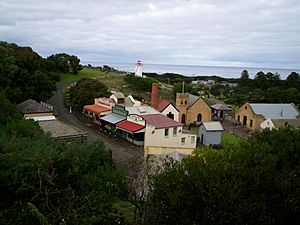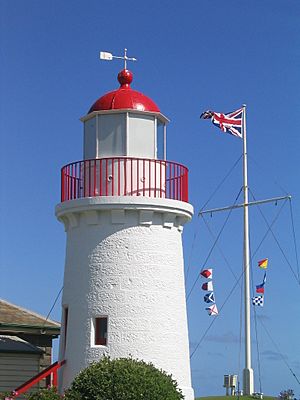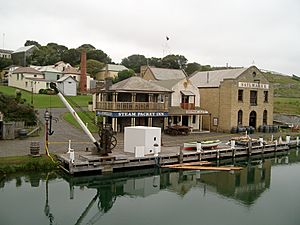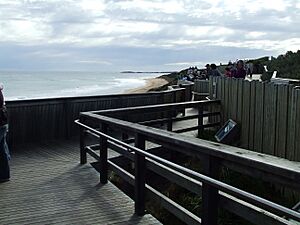Warrnambool facts for kids
Quick facts for kids WarrnamboolVictoria |
|||||||||
|---|---|---|---|---|---|---|---|---|---|
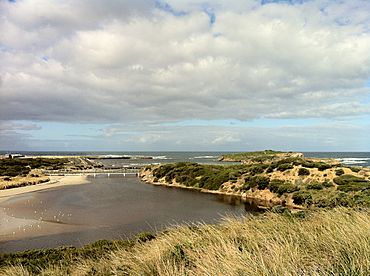
Warrnambool foreshore from Pickering Point
|
|||||||||
| Population | 35,743 (2021) | ||||||||
| Established | 1855 | ||||||||
| Postcode(s) | 3280 | ||||||||
| Time zone | AEST (UTC+10) | ||||||||
| • Summer (DST) | AEST (UTC+11) | ||||||||
| Location | |||||||||
| LGA(s) | City of Warrnambool | ||||||||
| State electorate(s) | South-West Coast | ||||||||
| Federal Division(s) | Wannon | ||||||||
|
|||||||||
Warrnambool is a city located on the south-western coast of Victoria, Australia. In 2021, about 35,743 people lived there. Warrnambool is found on the Princes Highway and marks the western end of the famous Great Ocean Road. It is also the southern end of the Hopkins Highway.
Contents
History of Warrnambool
Where the Name Came From
The name "Warrnambool" comes from Mount Warrnambool. This is a volcano about 25 kilometres northeast of the city. The name Warrnambool (or Warrnoobul) was used for both the volcano and the local Aboriginal Australian clan who lived there. In their language, "Warnn-" meant home or hut. The meaning of "-ambool" is not known today.
In 1845, a surveyor named William Fowler Pickering chose to name the new town Warrnambool. The traditional Indigenous owners of this land are the Dhauwurd Wurrung people.
First Australians in the Area
Aboriginal Australians have lived in the Warrnambool area for at least 35,000 years. The people living near the Merri River were called the Merrigundidj. They were part of the larger Gunditjmara nation. They spoke a language called Bi:gwurrung.
These people built clever stone and timber traps called yereroc to catch eels in the waterways. The area at the mouth of the Hopkins River was known as Moyjil. When British settlers arrived in 1841, about 400 Aboriginal people lived near the Merri River. Some Koroitgundidj people lived in a village at what is now Tower Hill.
There are also several local names for places in the area:
- 'Kunang' was a waterhole on Koroit Street where kangaroos drank.
- 'Wirkneung' is the site of the Warrnambool cemetery.
- 'Puurkar' refers to the Western Hill area.
- 'Peetoop' is one name for the area, meaning 'small sandpiper'.
Early European Visits
There's a story that the first Europeans to visit were from Portugal in the 1500s. This is based on unproven reports of a "mahogany ship" wreck. However, there is no real proof that this ship ever existed.
The first recorded European visit was in December 1800. A Scottish explorer named Lieutenant James Grant sailed along the coast. Later, in 1802, English navigator Matthew Flinders and French explorer Nicholas Baudin also explored the area. Whalers often visited the coast in the early 1800s.
British Settlement Begins
British settlement started in 1838. Captain Alexander Campbell, a whaler, took over 4,000 acres near the Merri River. He started a farm and built his main hut where Warrnambool is today.
The town was planned in 1845, and the first land was sold in 1847. A Post Office opened on January 1, 1849. During the Victorian Gold Rush in the 1850s, Warrnambool became an important port. It grew quickly and became a municipality in 1855. Warrnambool was officially called a town in 1883 and a city in 1918.
Climate
Warrnambool has a mild climate. Summers are usually warm and dry, while winters are cool and rainy. It gets more rain than Melbourne, especially in winter.
In February 2009, during a heatwave, Warrnambool recorded a very hot day of 44.8 degrees Celsius (112.6 degrees Fahrenheit).
| Climate data for Warrnambool Airport NDB (1998–2021); 38.29° S, 142.45° E | |||||||||||||
|---|---|---|---|---|---|---|---|---|---|---|---|---|---|
| Month | Jan | Feb | Mar | Apr | May | Jun | Jul | Aug | Sep | Oct | Nov | Dec | Year |
| Record high °C (°F) | 44.3 (111.7) |
44.8 (112.6) |
40.9 (105.6) |
35.6 (96.1) |
27.9 (82.2) |
22.4 (72.3) |
18.5 (65.3) |
22.9 (73.2) |
26.3 (79.3) |
32.7 (90.9) |
38.3 (100.9) |
44.2 (111.6) |
44.8 (112.6) |
| Mean daily maximum °C (°F) | 24.7 (76.5) |
24.6 (76.3) |
23.1 (73.6) |
20.0 (68.0) |
16.5 (61.7) |
14.1 (57.4) |
13.4 (56.1) |
14.3 (57.7) |
16.0 (60.8) |
18.0 (64.4) |
20.5 (68.9) |
22.6 (72.7) |
19.0 (66.2) |
| Mean daily minimum °C (°F) | 11.9 (53.4) |
12.4 (54.3) |
11.0 (51.8) |
9.0 (48.2) |
7.5 (45.5) |
5.8 (42.4) |
5.5 (41.9) |
5.8 (42.4) |
6.7 (44.1) |
7.4 (45.3) |
9.1 (48.4) |
10.2 (50.4) |
8.5 (47.3) |
| Record low °C (°F) | 2.3 (36.1) |
1.8 (35.2) |
2.0 (35.6) |
0.0 (32.0) |
−1.7 (28.9) |
−3.4 (25.9) |
−2 (28) |
−1.4 (29.5) |
−1.7 (28.9) |
−1.4 (29.5) |
0.8 (33.4) |
1.3 (34.3) |
−3.4 (25.9) |
| Average precipitation mm (inches) | 36.6 (1.44) |
30.1 (1.19) |
47.3 (1.86) |
53.8 (2.12) |
76.4 (3.01) |
77.6 (3.06) |
84.9 (3.34) |
93.3 (3.67) |
74.5 (2.93) |
67.2 (2.65) |
50.9 (2.00) |
45.4 (1.79) |
738.0 (29.06) |
| Average precipitation days (≥ 0.2 mm) | 8.8 | 8.8 | 12.7 | 15.5 | 20.5 | 20.0 | 21.6 | 21.9 | 19.4 | 17.7 | 13.8 | 11.9 | 192.6 |
| Source: Bureau of Meteorology. | |||||||||||||
| Climate data for Warnambool Post Office | |||||||||||||
|---|---|---|---|---|---|---|---|---|---|---|---|---|---|
| Month | Jan | Feb | Mar | Apr | May | Jun | Jul | Aug | Sep | Oct | Nov | Dec | Year |
| Record high °C (°F) | 44.4 (111.9) |
43.9 (111.0) |
40.0 (104.0) |
34.4 (93.9) |
30.7 (87.3) |
23.1 (73.6) |
22.5 (72.5) |
24.0 (75.2) |
34.4 (93.9) |
33.8 (92.8) |
38.9 (102.0) |
42.5 (108.5) |
44.4 (111.9) |
| Mean daily maximum °C (°F) | 22.2 (72.0) |
22.3 (72.1) |
21.1 (70.0) |
18.6 (65.5) |
16.1 (61.0) |
13.9 (57.0) |
13.3 (55.9) |
14.1 (57.4) |
15.7 (60.3) |
17.4 (63.3) |
19.0 (66.2) |
20.7 (69.3) |
17.9 (64.2) |
| Mean daily minimum °C (°F) | 12.8 (55.0) |
13.3 (55.9) |
12.3 (54.1) |
10.4 (50.7) |
8.7 (47.7) |
6.9 (44.4) |
6.2 (43.2) |
6.7 (44.1) |
7.7 (45.9) |
9.0 (48.2) |
10.1 (50.2) |
11.6 (52.9) |
9.6 (49.3) |
| Record low °C (°F) | 0.0 (32.0) |
4.2 (39.6) |
3.7 (38.7) |
1.7 (35.1) |
−0.9 (30.4) |
−0.6 (30.9) |
−1.9 (28.6) |
−1.6 (29.1) |
1.1 (34.0) |
1.0 (33.8) |
1.7 (35.1) |
4.2 (39.6) |
−1.9 (28.6) |
| Average rainfall mm (inches) | 32.9 (1.30) |
34.3 (1.35) |
47.6 (1.87) |
60.3 (2.37) |
77.5 (3.05) |
76.9 (3.03) |
88.3 (3.48) |
85.6 (3.37) |
73.7 (2.90) |
66.7 (2.63) |
54.8 (2.16) |
44.4 (1.75) |
741.9 (29.21) |
| Average rainy days (≥ 1.0 mm) | 4.5 | 4.3 | 5.5 | 8.4 | 10.8 | 11.4 | 13.4 | 13.2 | 10.9 | 9.4 | 7.5 | 6.4 | 105.7 |
| Source: Australian Bureau of Meteorology | |||||||||||||
City Layout and Landmarks
The original part of Warrnambool was set up in a grid pattern. Liebig Street is now the main street in the city centre. You'll notice many roundabouts there!
The Warrnambool Botanic Gardens are beautiful. They have wide paths, rare trees, a lily pond with ducks, and a fernery. A famous landscape architect, William Guilfoyle, designed them.
Warrnambool has several suburbs around its city centre. These include North, South, East, and West Warrnambool, Brierly, Sherwood Park, Merrivale, Dennington, Woodford, Bushfield, and Allansford.
Culture and Attractions
The Wunta Fiesta is a big community festival held every February. It offers lots of music and fun for people of all ages.
The Flagstaff Hill Maritime Museum is a popular place to visit. It's built on Flagstaff Hill, where the original lighthouses and an old fort are located. The museum has many items from shipwrecks and old sea trade. Its most famous item is a beautiful peacock statue saved from the shipwrecked Loch Ard.
The lighthouses at Flagstaff Hill are very old. They were moved there in 1878 and still help guide ships into Warrnambool harbour today.
The Warrnambool foreshore is a great place for swimming. It's next to the Lake Pertobe parklands, which are also popular. Many caravan parks are in this area for visitors.
The 2015 movie Oddball, starring Shane Jacobson, was filmed in Warrnambool.
Warrnambool's Bathing History
Warrnambool has been a popular spot for outdoor swimming for over 150 years. The first public bathing area was built in 1876. Later, in 1881, the Hot Sea Baths opened. People would travel to Warrnambool to enjoy these baths, believing they had "wonderful creative powers" and were good for health.
Today, Warrnambool still offers great bathing experiences. The Deep Blue Hot Springs use naturally warm geothermal water. This water comes from 850 meters (929 yards) below the earth's surface. They have both an Indoor Bath House and an Outdoor Bathing Sanctuary.
Media and News
Warrnambool has its own daily newspaper, The Standard. There are also local radio stations like 94.5 3YB and 95.3 Coast FM. You can also listen to the community radio channel, 3WAY FM, and ABC South West Victoria.
Local TV news is produced by WIN Television. They use resources from their newsrooms in Ballarat and Warrnambool.
Sports in Warrnambool
Warrnambool is famous for the Grand Annual Sprintcar Classic. This race brings drivers from Australia and other countries every year.
The city is also the finish line for the Melbourne to Warrnambool Classic cycle race. This is the longest one-day bike endurance race in the world. It has been held every October since 1895, making it the world's second oldest bike race.
Horse racing is popular here too. The Warrnambool Racing Club holds many races each year. This includes the Warrnambool Cup and the Grand Annual Steeple meeting in May. The Grand Annual steeplechase has 33 jumps, which is more than almost any other horse race.
The Warrnambool Greyhound Racing Club also holds regular greyhound racing meetings.
The Premier Speedway is a 410-meter (448-yard) dirt track oval. It hosts many important races, including the Grand Annual Sprintcar Classic. This is the biggest sprint car racing event in Australia.
Australian rules football is very popular in Warrnambool. The city has three teams in the Hampden Football League and many more in the Warrnambool District Football League. Many famous AFL players come from Warrnambool.
Golfers can play at the 18-hole Warrnambool Golf Club or the 9-hole course at Deakin University.
Economy and Jobs
Warrnambool welcomes many visitors each year. It's a central hub for services in the region. Tourism is boosted by the beautiful views from the Great Ocean Road and its nearby beaches, which are great for surfing.
In winter, you can see Southern Right whales at Logan's Beach. This is a special nursery area where mothers give birth to their calves. You can even take whale-watching tours.
The main part of Warrnambool's economy is farming, especially dairy farming. This includes milk processing. Other important industries are shops, education, healthcare, meat processing, and building.
People and Population
About 15.1% of people in Warrnambool were born outside Australia. Most people (89.1%) speak only English at home. About 2.0% of the population are Indigenous.
Government and Politics
The local government for Warrnambool is the Warrnambool City Council.
At the state level, Warrnambool is part of the South-West Coast electorate. This area is currently represented by Roma Britnell from the Liberal Party.
At the national level, Warrnambool is the largest town in the division of Wannon. This area has been a safe Liberal seat since 1955. Famous politicians like former Prime Minister Malcolm Fraser and former Speaker David Hawker have held this seat.
Education in Warrnambool
Warrnambool has many schools for different age groups.
Primary Schools
- Warrnambool Primary School
- Warrnambool East Primary School
- Warrnambool West Primary School
- Merrivale Primary School
- Allansford and District Primary School
- Grassmere Primary School
- Woodford Primary School
- Our Lady Help of Christians Primary School (Catholic)
- St Joseph's Primary School (Catholic)
- St Pius X Primary School (Catholic)
- St John's Primary School, Dennington (Catholic)
- Kings College (primary and secondary)
- Merri River School (for students with special needs)
Secondary Schools
Warrnambool has two public high schools:
- Brauer College
- Warrnambool College
There are also private schools:
- Emmanuel College, a Catholic school
- King's College, a private Presbyterian school
University and Vocational Training
The city has a Deakin University campus. The South West Institute of TAFE and SEAL offer vocational education, which teaches job-specific skills.
Environment and Wildlife
Logan's Beach is a special place for southern right whales. Female whales come here between May and August to give birth. The baby whales stay and grow here until September. Many tourists visit to watch these amazing whales from the shore.
Other animals you might see along the coast include Australian fur seals, little penguins, and common dolphins. In winter and spring, albatross birds can be seen flying along the coastline from Thunder Point.
Middle Island has a colony of Australian little penguins. Years ago, foxes caused their numbers to drop a lot. In 2005, only four penguins were left! To help, Warrnambool City Council started a unique program. They used Maremma dogs to guard the penguins. This program worked, and by 2015, the penguin population grew to almost two hundred. The film Oddball tells the story of these dogs saving the penguins.
Getting Around Warrnambool
Warrnambool is on the Princes Highway. This highway connects it to Port Fairy in the west and Terang in the east. The Hopkins Highway also ends here. The Great Ocean Road finishes about 13 kilometres east of Warrnambool.
You can travel by train to Melbourne and Geelong. V/Line passenger trains stop at Warrnambool's two stations: Warrnambool and Sherwood Park. There's also a daily freight train service.
Local buses cover Warrnambool and its suburbs. They also go to nearby towns like Port Fairy and Koroit. V/Line coaches connect Warrnambool to other towns like Mount Gambier, Ballarat, and Ararat.
Famous People from Warrnambool
- Airbourne, a hard rock band
- Tom Ballard (born 1989), comedian
- Ben Barber (born 1984), actor
- Smoky Dawson (1913–2008), country music performer
- Alex Dyson (born 1988), radio presenter
- Sir John Eccles (1903–1997), Nobel Prize winner for medicine
- Dave Hughes (born 1970), comedian
- Paul Jennings (born 1943), children's author (lives in Warrnambool)
- Axle Whitehead (born 1980), musician and TV personality
Sports Stars
Many Australian rules football players come from Warrnambool, including:
- Jonathan Brown
- Leon Cameron
- Paul Couch
- Jordan Lewis
- Brent Moloney
- Wayne Schwass
Other sports stars include:
- Marc Leishman (born 1983), golfer
- Christian Ryan (born 1977), Olympic Silver Medallist in rowing
- Nathan Sobey (born 1990), basketball player
- Tim Ludeman, cricket player
Sister Cities
Warrnambool has friendly connections with cities in other countries:
- Miura, Kanagawa, Japan
- Changchun, Jilin Province, P.R.China
- Knoxville, Iowa, United States of America
See also
 In Spanish: Warrnambool para niños
In Spanish: Warrnambool para niños


